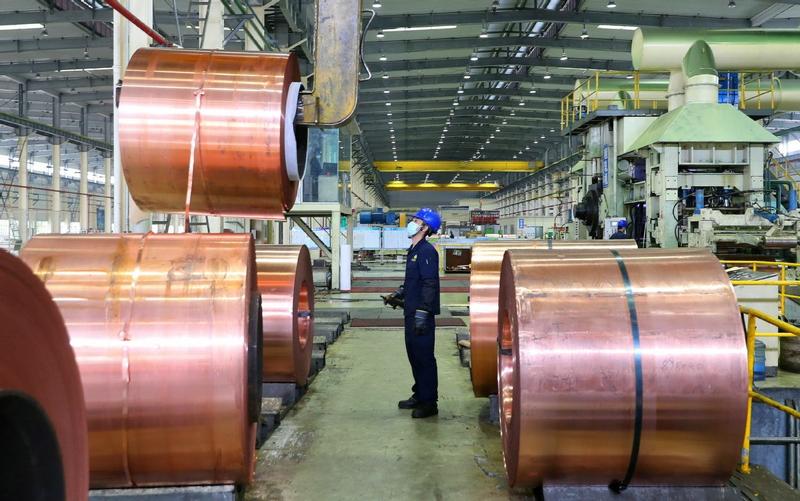 An employee works at a copper roll production facility in Dongyang, Zhejiang province, on Feb 27, 2021. (PHOYO BY BAO KANGXUAN / FOR CHINA DAILY)
An employee works at a copper roll production facility in Dongyang, Zhejiang province, on Feb 27, 2021. (PHOYO BY BAO KANGXUAN / FOR CHINA DAILY)
Although copper prices hit an almost 10-year high recently, they will likely find good support at relatively high levels in the next several years, analysts said.
That is because demand from the renewable energy sector is rising, supplies of concentrate are tight and inflationary expectations are piling up, they said.
Benchmark copper on the London Metal Exchange climbed to US$9,617 per metric ton in the last week of February, setting a new high for the past nine-and-a-half years.
The all-time high of US$10,190 a ton was reached in February 2011.
But the key price of the red metal is likely to rise to a new high this year, and may be followed by a correction and then fluctuations as inflationary expectations weaken, analysts said.
Wei Lai, a senior nonferrous metals analyst with the Tianfeng Future Research Institute, said the recent copper price spike is just a reflection of optimism about global economic recovery and most importantly, the market response to the United States stimulus package
Li Qi, co-head of the base metal segment at consultancy firm Shanghai Ganglian E-commerce Holding Co, known as Mysteel, said the surge in copper prices in the past few months was fueled by a combination of macroeconomic factors and fundamentals.
For one, there have been the coronavirus-related disruptions to logistics and output. For another, strong fiscal and monetary stimulus measures globally have had an impact.
These were followed by demand recovery in China and abroad, and new demand from the construction sector and green applications, like wind and solar power infrastructure, and electric vehicles.
"The COVID-19 pandemic has disrupted copper concentrate output and shipments. In addition, a stronger factor underpinning the copper price spike recently is the monetary stimulus measures adopted by major economies. This has boosted expectations of inflation," she said.
"Besides, rising green-related demand is also exerting pressure on the already tight supply."
So, over the next three to five years, copper prices at the current high levels are expected to be well supported by demand expansion, analysts said.
As the world transfers to a cleaner energy mix and pushes for a greener future, demand for copper from the renewable energy sector and the electric vehicle sector has been growing fast.
Meanwhile, the copper smelting and refining sectors, which are carbon-intensive, may realize that production expansion will likely get constrained in the next decades, Li said.
Wei Lai, a senior nonferrous metals analyst with the Tianfeng Future Research Institute, said the recent copper price spike is just a reflection of optimism about global economic recovery and most importantly, the market response to the United States stimulus package.
Noting that production facilities have not increased capacities in recent times, Wei said he is positive about the high copper prices staying firm in next few years if traditional demand remains strong.
"China's copper consumption is likely to grow as it targets a GDP growth rate of above 6 percent this year. Given expectations of more fiscal stimulus for new construction from the US and global economic recovery, a retaliatory rebound in copper consumption is likely worldwide this summer.
ALSO READ: Zhejiang Hailiang plans copper tube factory in US
"But supply cannot expand immediately to meet rising demand due to the absence of new capacity projects over the past few years."
He also underlined that the current high prices will likely receive support from demand growth in emerging green industries.
The Tianfeng Future Research Institute predicted that green industries' copper consumption will account for 8 percent of total copper consumption, 4 percentage points higher than the current level.
Both Wei and Li said they expect a correction in copper prices this year, but their views diverged on its likely timing.
According to Li, the price will see downturn momentum during the second half.
The first quarter has seen tightened supply of copper concentrate, which resulted in declining treatment charges.
Copper smelters are likely to slow down production in the second quarter on negative production margin, which will likely further support the current high copper prices.
However, given the rollout of the COVID-19 vaccines and concerns over possible US monetary policy shifts in the following several months, alongside copper scrap and concentrate supply recovery, copper prices are likely to be depressed in the second half, Li said.
Wei said it is widely agreed that copper prices will likely see a correction when expectations of inflation weaken as monetary policy is expected to shift in the US.
In a recent report, China International Capital Co Ltd, or CICC, said the rise in prices of commodities is self-limiting and cannot last long, because changes in corporate profits caused by the price rise will give rise to adjustments in production capacity.
READ MORE: Experts: Inflation rise due to commodity not so worrisome
China accounts for more than half of the world's copper apparent consumption, and the rise in copper prices has already impacted downstream profits, according to the report.


